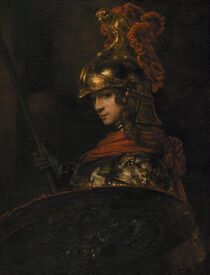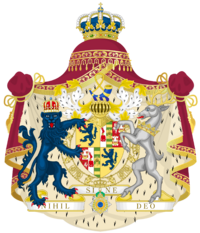Mascane: Difference between revisions
No edit summary |
mNo edit summary |
||
| Line 1: | Line 1: | ||
{{WIP}} | |||
[[File:Peter Paul Rubens - Marie de Medicis as Bellona2.jpg|190px|thumb|right|''Mascane, Goddess and Matron of War, Country, and Mascylla'' by Rubrecht Pallen (1798), celebrating the [[War of the Five Kings|Mascyllary unification]] (National Arts Museum).]] | [[File:Peter Paul Rubens - Marie de Medicis as Bellona2.jpg|190px|thumb|right|''Mascane, Goddess and Matron of War, Country, and Mascylla'' by Rubrecht Pallen (1798), celebrating the [[War of the Five Kings|Mascyllary unification]] (National Arts Museum).]] | ||
[[File:Mascane of Mascylla.jpg|210px|thumb|right|''Mascane of Mascylla'' by Erich Dühlen (1812)]] | [[File:Mascane of Mascylla.jpg|210px|thumb|right|''Mascane of Mascylla'' by Erich Dühlen (1812)]] | ||
'''Mascane''' or '''Mascana''' ({{wp|German language|Hesurian}}: '''''Maskane'''''; <small>pronounced:</small> {{wp|Help:IPA/Standard German|[mas'kɐn]}} is the {{wp|national personification}} of the [[Crowned Republic of Mascylla]], introduced in the years of its founding in the [[War of the Five Kings]], as a {{wp|personification}} of {{wp|warfare}}, {{wp|self-determination}}, {{wp|wisdom}}, and {{wp|liberty}}, and a portrayal of the {{wp|Goddess of Liberty}} and {{wp|Athena|Goddess of War}}. | '''Mascane''' or '''Mascana''' ({{wp|German language|Hesurian}}: '''''Maskane'''''; <small>pronounced:</small> {{wp|Help:IPA/Standard German|[mas'kɐn]}} is the {{wp|national personification}} of the [[Crowned Republic of Mascylla]], introduced in the years of its founding in the [[War of the Five Kings]], as a {{wp|personification}} of {{wp|warfare}}, {{wp|self-determination}}, {{wp|wisdom}}, and {{wp|liberty}}, and a portrayal of the {{wp|Goddess of Liberty}} and {{wp|Athena|Goddess of War}}. | ||
Mascane is displayed as a prone {{wp|symbol}} in various places in Mascylla, especially places of significance: holding {{wp|place of honour|places of honour}} in government and communal buildings, as statues and monuments, most notably as ''The Rider of the {{wp|Republic}}'' overlooking the Volksplatz, and as portrayal to various objects. It is printed on {{wp|banknote|banknotes}}, engraved on {{wp|coin|coins}}, featured on {{wp|postage stamp|postage stamps}}, and sometimes depicted on government documents. Mascane as a personality and {{wp|icon}} is one of the most prominent symbols of Mascylla. She is also described as a significant {{wp|republicanism|republican symbol}}, especially after the [[Mascyllary Revolution]], but also beforehand in the [[Mascyllary Kingdom]]. As such icon Mascane represents the opposition to {{wp|authoritarianism}} and the supremacy of {{wp|democracy}} and {{wp|self-determination}} against all forms of suppression. She is part of a limited set of Mascyllary symbols: the [[Flag of Mascylla|flag]], the [[Coat of arms of Mascylla|coat of arms]], the national motto ''Hir Stehen Wir'', and the national anthem ''[[Geeint in Blut und Schwur]]''. | Mascane is displayed as a prone {{wp|symbol}} in various places in Mascylla, especially places of significance: holding {{wp|place of honour|places of honour}} in government and communal buildings, as statues and monuments, most notably as ''The Rider of the {{wp|Republic}}'' overlooking the Volksplatz, and as portrayal to various objects. It is printed on {{wp|banknote|banknotes}}, engraved on {{wp|coin|coins}}, featured on {{wp|postage stamp|postage stamps}}, and sometimes depicted on government documents. Mascane as a personality and {{wp|icon}} is one of the most prominent symbols of Mascylla. She is also described as a significant {{wp|republicanism|republican symbol}}, especially after the [[Mascyllary Revolution]], but also beforehand in the [[Mascyllary Kingdom]]. As such icon Mascane represents the opposition to {{wp|authoritarianism}} and the supremacy of {{wp|democracy}} and {{wp|self-determination}} against all forms of suppression. She is part of a limited set of Mascyllary symbols: the [[Flag of Mascylla|flag]], the [[Coat of arms of Mascylla|coat of arms]], the national motto ''Hir Stehen Wir'', and the national anthem ''[[Geeint in Blut und Schwur]]''. | ||
==Origin and history== | |||
==Use== | |||
==Gallery== | |||
==See also== | |||
* [[National symbols of Mascylla]] | |||
[[Category:Mascylla]] {{Template:Mascyllatopics}} | [[Category:Mascylla]] | ||
{{Template:Mascyllatopics}} | |||
Latest revision as of 10:53, 27 December 2022
This article is incomplete because it is pending further input from participants, or it is a work-in-progress by one author. Please comment on this article's talk page to share your input, comments and questions. Note: To contribute to this article, you may need to seek help from the author(s) of this page. |

Mascane or Mascana (Hesurian: Maskane; pronounced: [mas'kɐn] is the national personification of the Crowned Republic of Mascylla, introduced in the years of its founding in the War of the Five Kings, as a personification of warfare, self-determination, wisdom, and liberty, and a portrayal of the Goddess of Liberty and Goddess of War.
Mascane is displayed as a prone symbol in various places in Mascylla, especially places of significance: holding places of honour in government and communal buildings, as statues and monuments, most notably as The Rider of the Republic overlooking the Volksplatz, and as portrayal to various objects. It is printed on banknotes, engraved on coins, featured on postage stamps, and sometimes depicted on government documents. Mascane as a personality and icon is one of the most prominent symbols of Mascylla. She is also described as a significant republican symbol, especially after the Mascyllary Revolution, but also beforehand in the Mascyllary Kingdom. As such icon Mascane represents the opposition to authoritarianism and the supremacy of democracy and self-determination against all forms of suppression. She is part of a limited set of Mascyllary symbols: the flag, the coat of arms, the national motto Hir Stehen Wir, and the national anthem Geeint in Blut und Schwur.

